Management Accounting Report: Financial Analysis of Rio Tinto
VerifiedAdded on 2023/01/13
|22
|5429
|59
Report
AI Summary
This report delves into the realm of management accounting, providing a detailed analysis of its principles and applications within a business context, using Rio Tinto as a case study. The report begins by defining management accounting and outlining its essential requirements, including cost accounting, inventory management systems, job costing, and price optimization. It explores the differences between financial and management accounting, emphasizing the internal focus of the latter. The core of the report examines various management accounting reporting methods, such as inventory reports, cost accounting reports, and performance reports. Furthermore, it presents a comparative analysis of costing techniques, specifically marginal and absorption costing, including detailed cost cards and profit and loss statements. The report also touches upon the use of budgetary planning tools and management accounting's role in solving financial problems, including financial governance for prevention. Finally, it highlights the characteristics of an effective management accountant and concludes with a summary of the key findings and their implications for Rio Tinto's financial management.
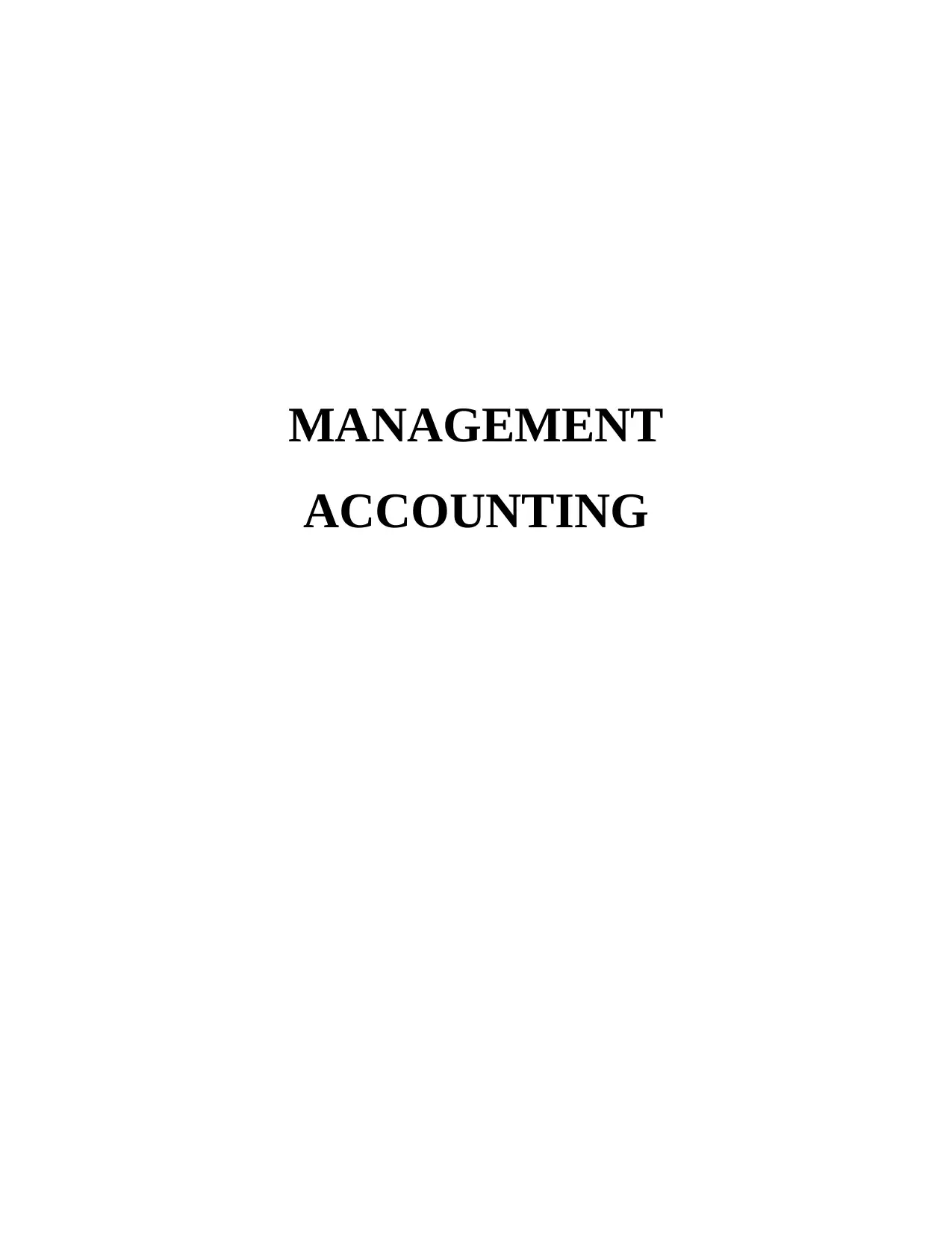
MANAGEMENT
ACCOUNTING
ACCOUNTING
Paraphrase This Document
Need a fresh take? Get an instant paraphrase of this document with our AI Paraphraser
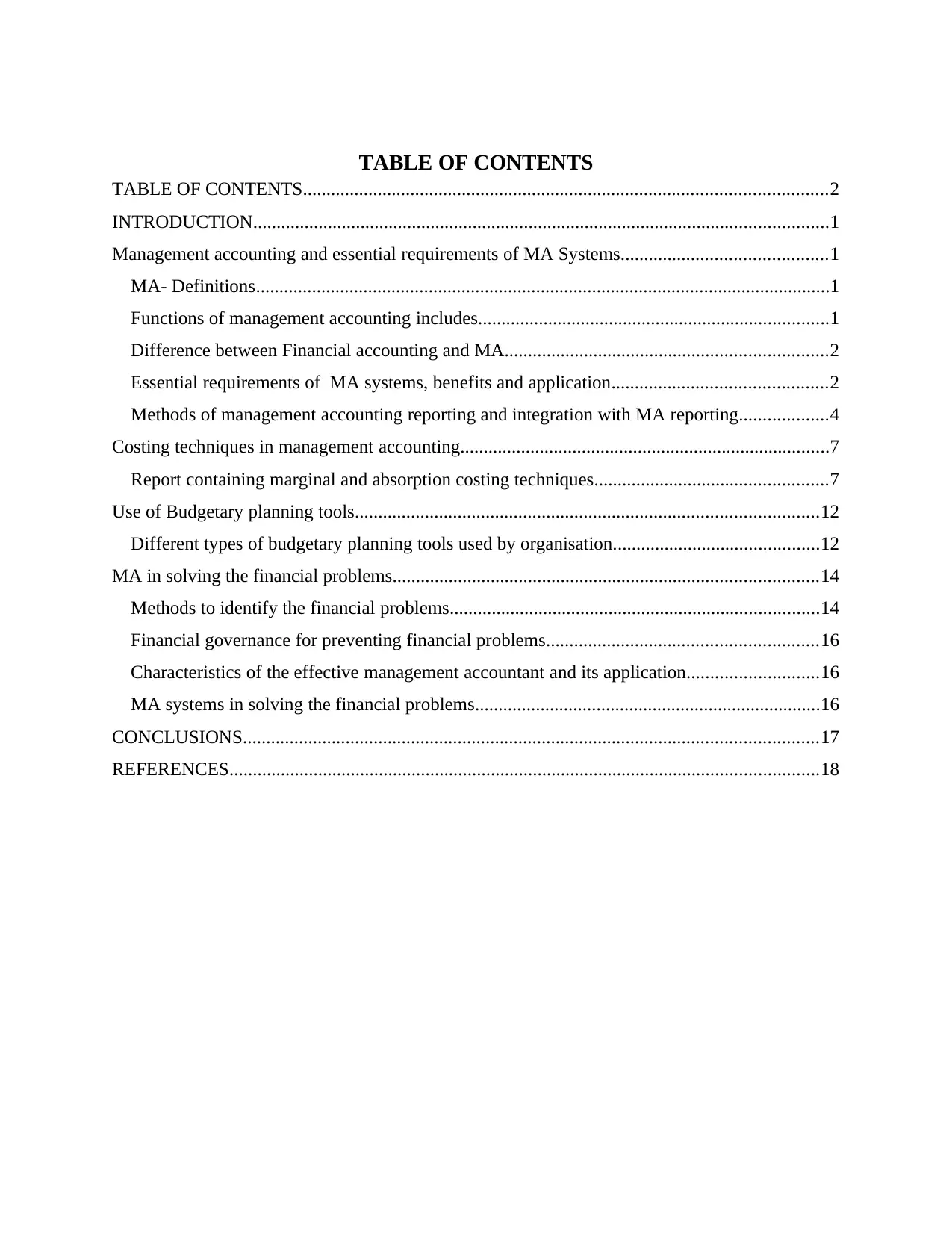
TABLE OF CONTENTS
TABLE OF CONTENTS................................................................................................................2
INTRODUCTION...........................................................................................................................1
Management accounting and essential requirements of MA Systems............................................1
MA- Definitions...........................................................................................................................1
Functions of management accounting includes...........................................................................1
Difference between Financial accounting and MA.....................................................................2
Essential requirements of MA systems, benefits and application..............................................2
Methods of management accounting reporting and integration with MA reporting...................4
Costing techniques in management accounting...............................................................................7
Report containing marginal and absorption costing techniques..................................................7
Use of Budgetary planning tools...................................................................................................12
Different types of budgetary planning tools used by organisation............................................12
MA in solving the financial problems...........................................................................................14
Methods to identify the financial problems...............................................................................14
Financial governance for preventing financial problems..........................................................16
Characteristics of the effective management accountant and its application............................16
MA systems in solving the financial problems..........................................................................16
CONCLUSIONS...........................................................................................................................17
REFERENCES..............................................................................................................................18
TABLE OF CONTENTS................................................................................................................2
INTRODUCTION...........................................................................................................................1
Management accounting and essential requirements of MA Systems............................................1
MA- Definitions...........................................................................................................................1
Functions of management accounting includes...........................................................................1
Difference between Financial accounting and MA.....................................................................2
Essential requirements of MA systems, benefits and application..............................................2
Methods of management accounting reporting and integration with MA reporting...................4
Costing techniques in management accounting...............................................................................7
Report containing marginal and absorption costing techniques..................................................7
Use of Budgetary planning tools...................................................................................................12
Different types of budgetary planning tools used by organisation............................................12
MA in solving the financial problems...........................................................................................14
Methods to identify the financial problems...............................................................................14
Financial governance for preventing financial problems..........................................................16
Characteristics of the effective management accountant and its application............................16
MA systems in solving the financial problems..........................................................................16
CONCLUSIONS...........................................................................................................................17
REFERENCES..............................................................................................................................18
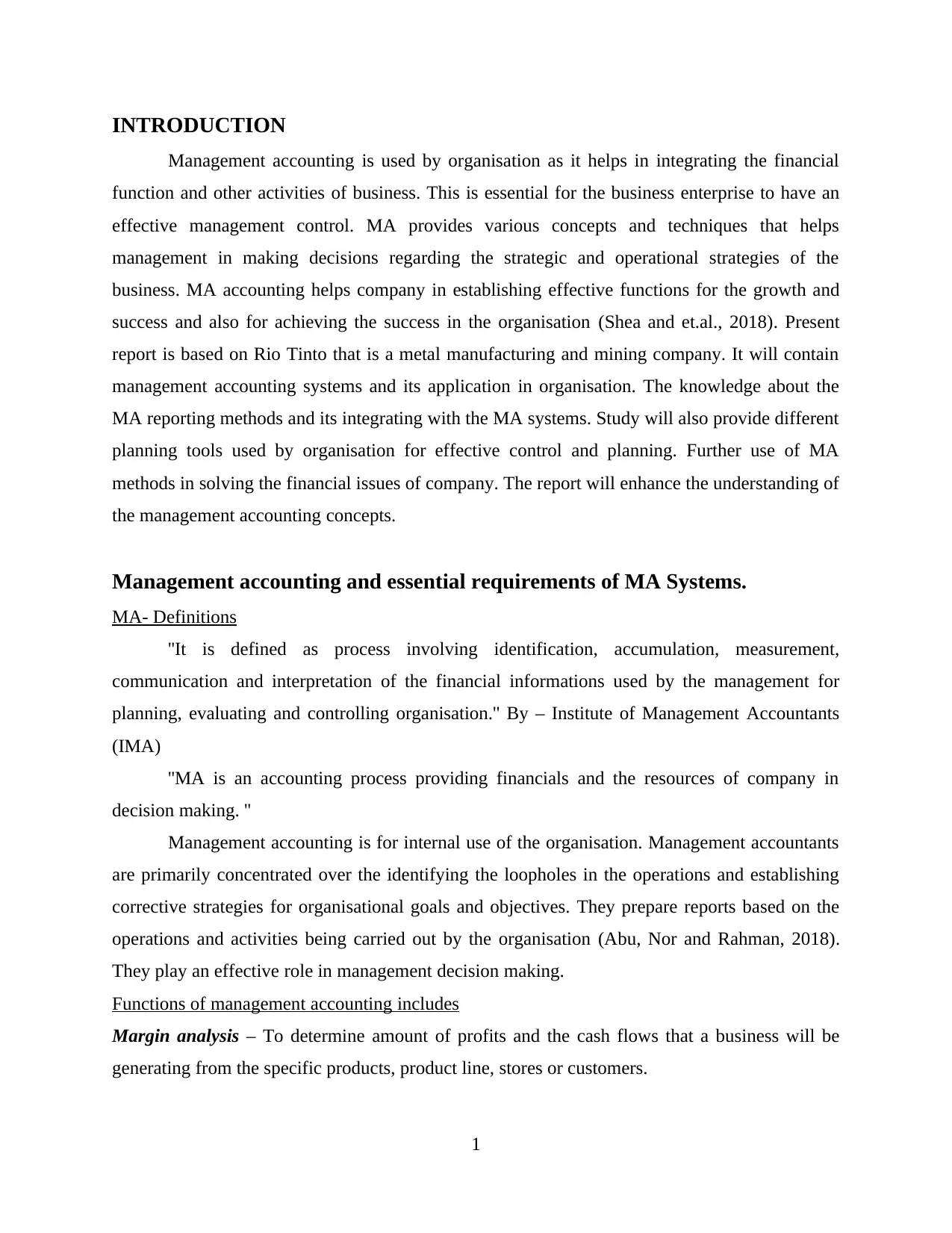
INTRODUCTION
Management accounting is used by organisation as it helps in integrating the financial
function and other activities of business. This is essential for the business enterprise to have an
effective management control. MA provides various concepts and techniques that helps
management in making decisions regarding the strategic and operational strategies of the
business. MA accounting helps company in establishing effective functions for the growth and
success and also for achieving the success in the organisation (Shea and et.al., 2018). Present
report is based on Rio Tinto that is a metal manufacturing and mining company. It will contain
management accounting systems and its application in organisation. The knowledge about the
MA reporting methods and its integrating with the MA systems. Study will also provide different
planning tools used by organisation for effective control and planning. Further use of MA
methods in solving the financial issues of company. The report will enhance the understanding of
the management accounting concepts.
Management accounting and essential requirements of MA Systems.
MA- Definitions
''It is defined as process involving identification, accumulation, measurement,
communication and interpretation of the financial informations used by the management for
planning, evaluating and controlling organisation.'' By – Institute of Management Accountants
(IMA)
''MA is an accounting process providing financials and the resources of company in
decision making. ''
Management accounting is for internal use of the organisation. Management accountants
are primarily concentrated over the identifying the loopholes in the operations and establishing
corrective strategies for organisational goals and objectives. They prepare reports based on the
operations and activities being carried out by the organisation (Abu, Nor and Rahman, 2018).
They play an effective role in management decision making.
Functions of management accounting includes
Margin analysis – To determine amount of profits and the cash flows that a business will be
generating from the specific products, product line, stores or customers.
1
Management accounting is used by organisation as it helps in integrating the financial
function and other activities of business. This is essential for the business enterprise to have an
effective management control. MA provides various concepts and techniques that helps
management in making decisions regarding the strategic and operational strategies of the
business. MA accounting helps company in establishing effective functions for the growth and
success and also for achieving the success in the organisation (Shea and et.al., 2018). Present
report is based on Rio Tinto that is a metal manufacturing and mining company. It will contain
management accounting systems and its application in organisation. The knowledge about the
MA reporting methods and its integrating with the MA systems. Study will also provide different
planning tools used by organisation for effective control and planning. Further use of MA
methods in solving the financial issues of company. The report will enhance the understanding of
the management accounting concepts.
Management accounting and essential requirements of MA Systems.
MA- Definitions
''It is defined as process involving identification, accumulation, measurement,
communication and interpretation of the financial informations used by the management for
planning, evaluating and controlling organisation.'' By – Institute of Management Accountants
(IMA)
''MA is an accounting process providing financials and the resources of company in
decision making. ''
Management accounting is for internal use of the organisation. Management accountants
are primarily concentrated over the identifying the loopholes in the operations and establishing
corrective strategies for organisational goals and objectives. They prepare reports based on the
operations and activities being carried out by the organisation (Abu, Nor and Rahman, 2018).
They play an effective role in management decision making.
Functions of management accounting includes
Margin analysis – To determine amount of profits and the cash flows that a business will be
generating from the specific products, product line, stores or customers.
1
⊘ This is a preview!⊘
Do you want full access?
Subscribe today to unlock all pages.

Trusted by 1+ million students worldwide
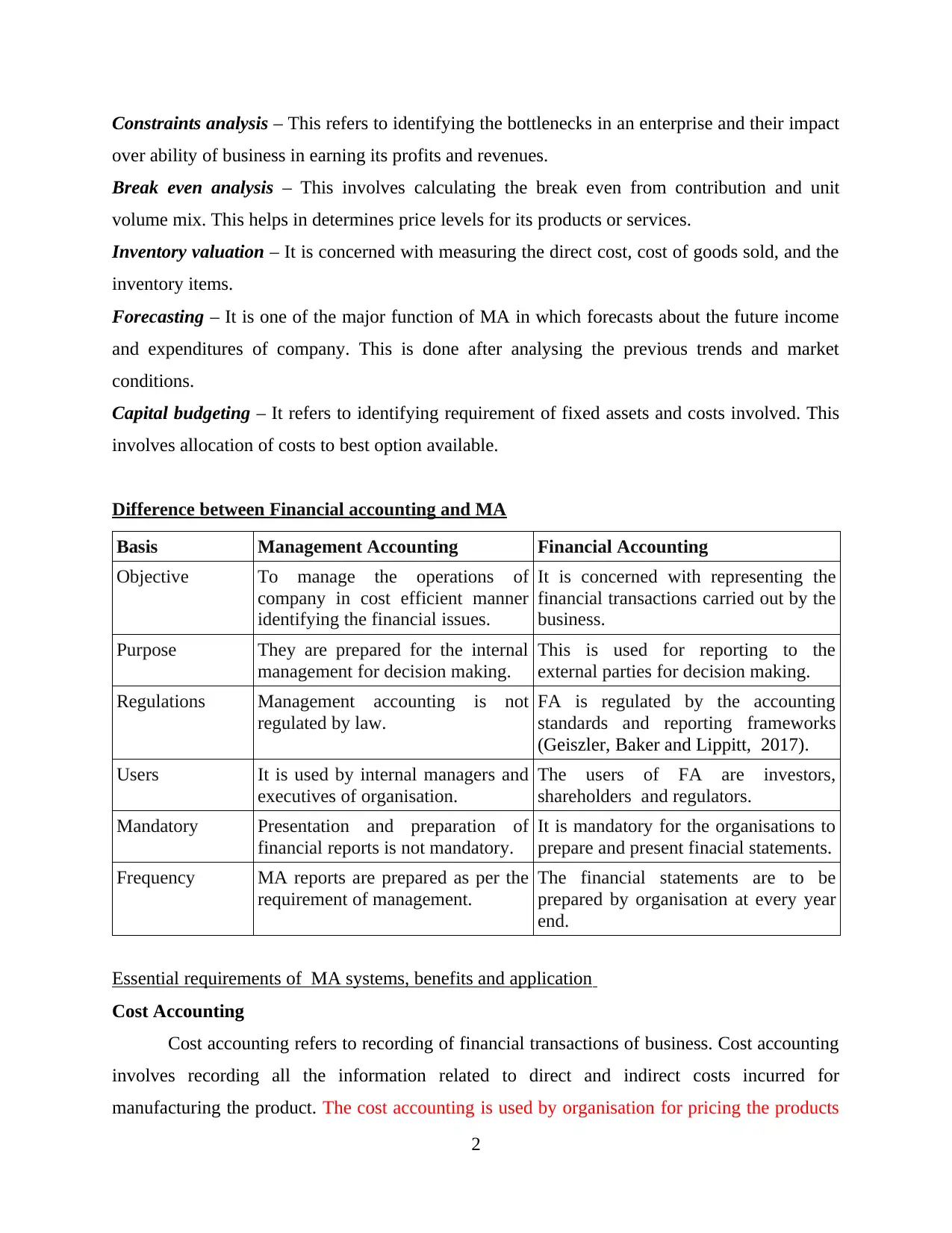
Constraints analysis – This refers to identifying the bottlenecks in an enterprise and their impact
over ability of business in earning its profits and revenues.
Break even analysis – This involves calculating the break even from contribution and unit
volume mix. This helps in determines price levels for its products or services.
Inventory valuation – It is concerned with measuring the direct cost, cost of goods sold, and the
inventory items.
Forecasting – It is one of the major function of MA in which forecasts about the future income
and expenditures of company. This is done after analysing the previous trends and market
conditions.
Capital budgeting – It refers to identifying requirement of fixed assets and costs involved. This
involves allocation of costs to best option available.
Difference between Financial accounting and MA
Basis Management Accounting Financial Accounting
Objective To manage the operations of
company in cost efficient manner
identifying the financial issues.
It is concerned with representing the
financial transactions carried out by the
business.
Purpose They are prepared for the internal
management for decision making.
This is used for reporting to the
external parties for decision making.
Regulations Management accounting is not
regulated by law.
FA is regulated by the accounting
standards and reporting frameworks
(Geiszler, Baker and Lippitt, 2017).
Users It is used by internal managers and
executives of organisation.
The users of FA are investors,
shareholders and regulators.
Mandatory Presentation and preparation of
financial reports is not mandatory.
It is mandatory for the organisations to
prepare and present finacial statements.
Frequency MA reports are prepared as per the
requirement of management.
The financial statements are to be
prepared by organisation at every year
end.
Essential requirements of MA systems, benefits and application
Cost Accounting
Cost accounting refers to recording of financial transactions of business. Cost accounting
involves recording all the information related to direct and indirect costs incurred for
manufacturing the product. The cost accounting is used by organisation for pricing the products
2
over ability of business in earning its profits and revenues.
Break even analysis – This involves calculating the break even from contribution and unit
volume mix. This helps in determines price levels for its products or services.
Inventory valuation – It is concerned with measuring the direct cost, cost of goods sold, and the
inventory items.
Forecasting – It is one of the major function of MA in which forecasts about the future income
and expenditures of company. This is done after analysing the previous trends and market
conditions.
Capital budgeting – It refers to identifying requirement of fixed assets and costs involved. This
involves allocation of costs to best option available.
Difference between Financial accounting and MA
Basis Management Accounting Financial Accounting
Objective To manage the operations of
company in cost efficient manner
identifying the financial issues.
It is concerned with representing the
financial transactions carried out by the
business.
Purpose They are prepared for the internal
management for decision making.
This is used for reporting to the
external parties for decision making.
Regulations Management accounting is not
regulated by law.
FA is regulated by the accounting
standards and reporting frameworks
(Geiszler, Baker and Lippitt, 2017).
Users It is used by internal managers and
executives of organisation.
The users of FA are investors,
shareholders and regulators.
Mandatory Presentation and preparation of
financial reports is not mandatory.
It is mandatory for the organisations to
prepare and present finacial statements.
Frequency MA reports are prepared as per the
requirement of management.
The financial statements are to be
prepared by organisation at every year
end.
Essential requirements of MA systems, benefits and application
Cost Accounting
Cost accounting refers to recording of financial transactions of business. Cost accounting
involves recording all the information related to direct and indirect costs incurred for
manufacturing the product. The cost accounting is used by organisation for pricing the products
2
Paraphrase This Document
Need a fresh take? Get an instant paraphrase of this document with our AI Paraphraser
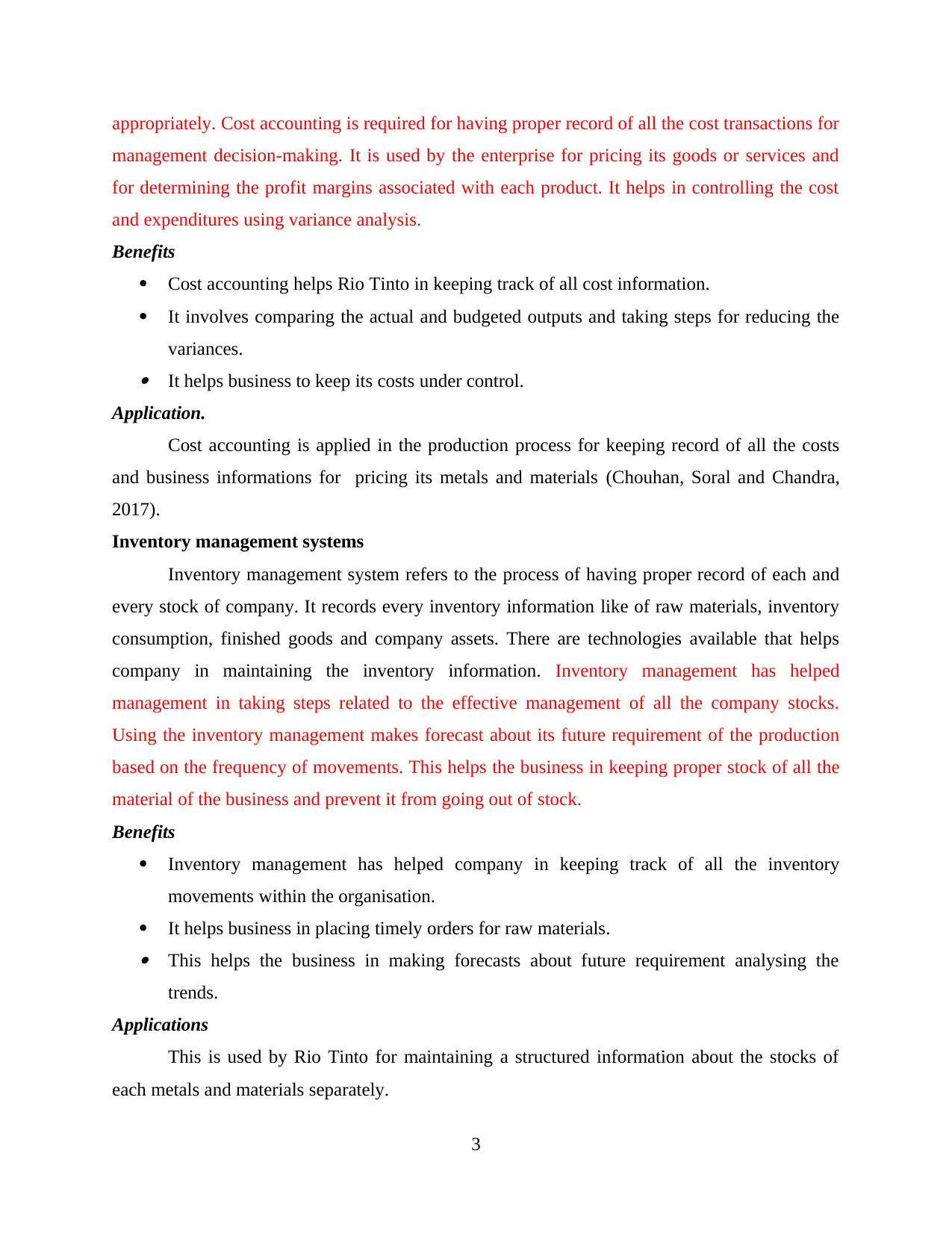
appropriately. Cost accounting is required for having proper record of all the cost transactions for
management decision-making. It is used by the enterprise for pricing its goods or services and
for determining the profit margins associated with each product. It helps in controlling the cost
and expenditures using variance analysis.
Benefits
Cost accounting helps Rio Tinto in keeping track of all cost information.
It involves comparing the actual and budgeted outputs and taking steps for reducing the
variances. It helps business to keep its costs under control.
Application.
Cost accounting is applied in the production process for keeping record of all the costs
and business informations for pricing its metals and materials (Chouhan, Soral and Chandra,
2017).
Inventory management systems
Inventory management system refers to the process of having proper record of each and
every stock of company. It records every inventory information like of raw materials, inventory
consumption, finished goods and company assets. There are technologies available that helps
company in maintaining the inventory information. Inventory management has helped
management in taking steps related to the effective management of all the company stocks.
Using the inventory management makes forecast about its future requirement of the production
based on the frequency of movements. This helps the business in keeping proper stock of all the
material of the business and prevent it from going out of stock.
Benefits
Inventory management has helped company in keeping track of all the inventory
movements within the organisation.
It helps business in placing timely orders for raw materials. This helps the business in making forecasts about future requirement analysing the
trends.
Applications
This is used by Rio Tinto for maintaining a structured information about the stocks of
each metals and materials separately.
3
management decision-making. It is used by the enterprise for pricing its goods or services and
for determining the profit margins associated with each product. It helps in controlling the cost
and expenditures using variance analysis.
Benefits
Cost accounting helps Rio Tinto in keeping track of all cost information.
It involves comparing the actual and budgeted outputs and taking steps for reducing the
variances. It helps business to keep its costs under control.
Application.
Cost accounting is applied in the production process for keeping record of all the costs
and business informations for pricing its metals and materials (Chouhan, Soral and Chandra,
2017).
Inventory management systems
Inventory management system refers to the process of having proper record of each and
every stock of company. It records every inventory information like of raw materials, inventory
consumption, finished goods and company assets. There are technologies available that helps
company in maintaining the inventory information. Inventory management has helped
management in taking steps related to the effective management of all the company stocks.
Using the inventory management makes forecast about its future requirement of the production
based on the frequency of movements. This helps the business in keeping proper stock of all the
material of the business and prevent it from going out of stock.
Benefits
Inventory management has helped company in keeping track of all the inventory
movements within the organisation.
It helps business in placing timely orders for raw materials. This helps the business in making forecasts about future requirement analysing the
trends.
Applications
This is used by Rio Tinto for maintaining a structured information about the stocks of
each metals and materials separately.
3
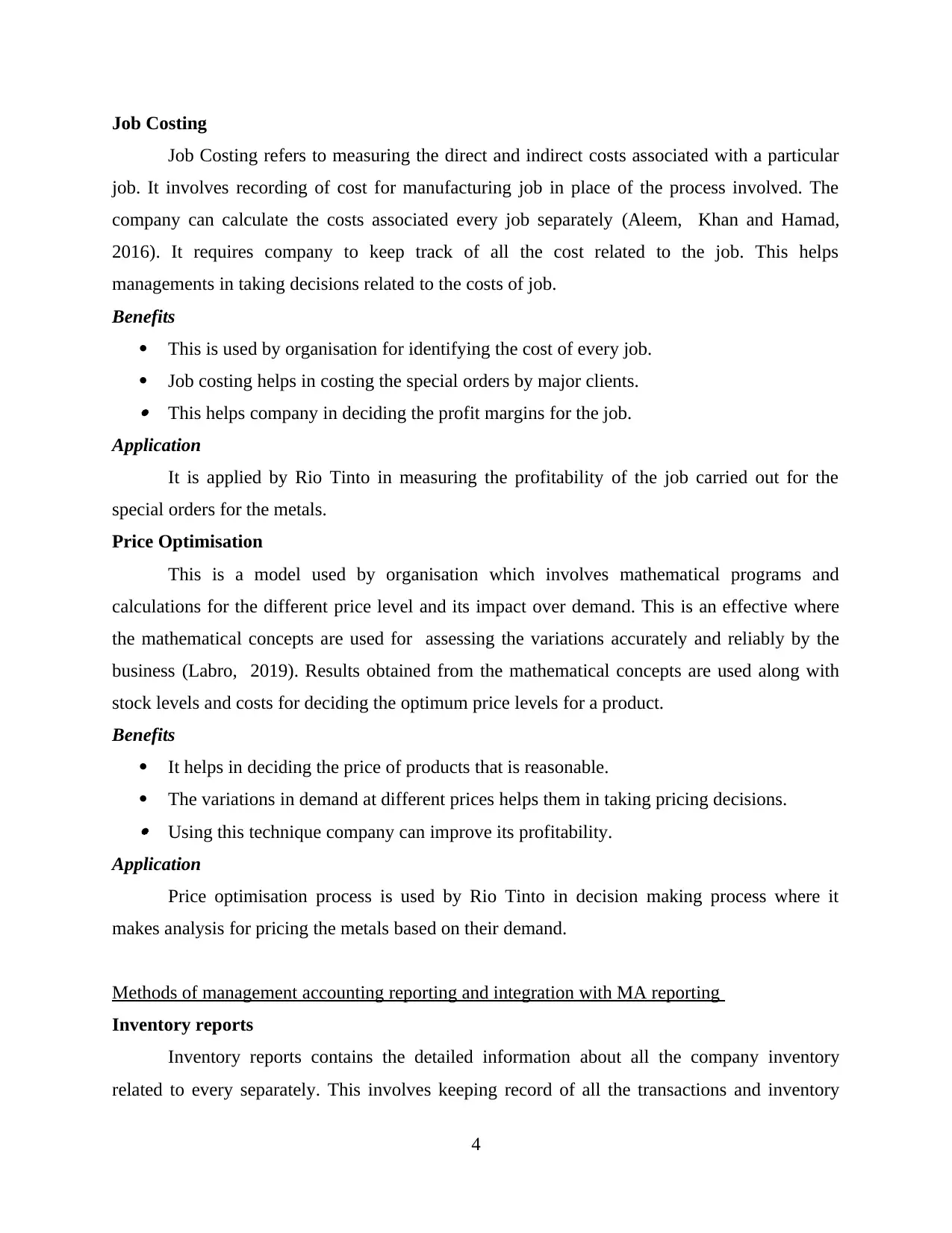
Job Costing
Job Costing refers to measuring the direct and indirect costs associated with a particular
job. It involves recording of cost for manufacturing job in place of the process involved. The
company can calculate the costs associated every job separately (Aleem, Khan and Hamad,
2016). It requires company to keep track of all the cost related to the job. This helps
managements in taking decisions related to the costs of job.
Benefits
This is used by organisation for identifying the cost of every job.
Job costing helps in costing the special orders by major clients. This helps company in deciding the profit margins for the job.
Application
It is applied by Rio Tinto in measuring the profitability of the job carried out for the
special orders for the metals.
Price Optimisation
This is a model used by organisation which involves mathematical programs and
calculations for the different price level and its impact over demand. This is an effective where
the mathematical concepts are used for assessing the variations accurately and reliably by the
business (Labro, 2019). Results obtained from the mathematical concepts are used along with
stock levels and costs for deciding the optimum price levels for a product.
Benefits
It helps in deciding the price of products that is reasonable.
The variations in demand at different prices helps them in taking pricing decisions. Using this technique company can improve its profitability.
Application
Price optimisation process is used by Rio Tinto in decision making process where it
makes analysis for pricing the metals based on their demand.
Methods of management accounting reporting and integration with MA reporting
Inventory reports
Inventory reports contains the detailed information about all the company inventory
related to every separately. This involves keeping record of all the transactions and inventory
4
Job Costing refers to measuring the direct and indirect costs associated with a particular
job. It involves recording of cost for manufacturing job in place of the process involved. The
company can calculate the costs associated every job separately (Aleem, Khan and Hamad,
2016). It requires company to keep track of all the cost related to the job. This helps
managements in taking decisions related to the costs of job.
Benefits
This is used by organisation for identifying the cost of every job.
Job costing helps in costing the special orders by major clients. This helps company in deciding the profit margins for the job.
Application
It is applied by Rio Tinto in measuring the profitability of the job carried out for the
special orders for the metals.
Price Optimisation
This is a model used by organisation which involves mathematical programs and
calculations for the different price level and its impact over demand. This is an effective where
the mathematical concepts are used for assessing the variations accurately and reliably by the
business (Labro, 2019). Results obtained from the mathematical concepts are used along with
stock levels and costs for deciding the optimum price levels for a product.
Benefits
It helps in deciding the price of products that is reasonable.
The variations in demand at different prices helps them in taking pricing decisions. Using this technique company can improve its profitability.
Application
Price optimisation process is used by Rio Tinto in decision making process where it
makes analysis for pricing the metals based on their demand.
Methods of management accounting reporting and integration with MA reporting
Inventory reports
Inventory reports contains the detailed information about all the company inventory
related to every separately. This involves keeping record of all the transactions and inventory
4
⊘ This is a preview!⊘
Do you want full access?
Subscribe today to unlock all pages.

Trusted by 1+ million students worldwide
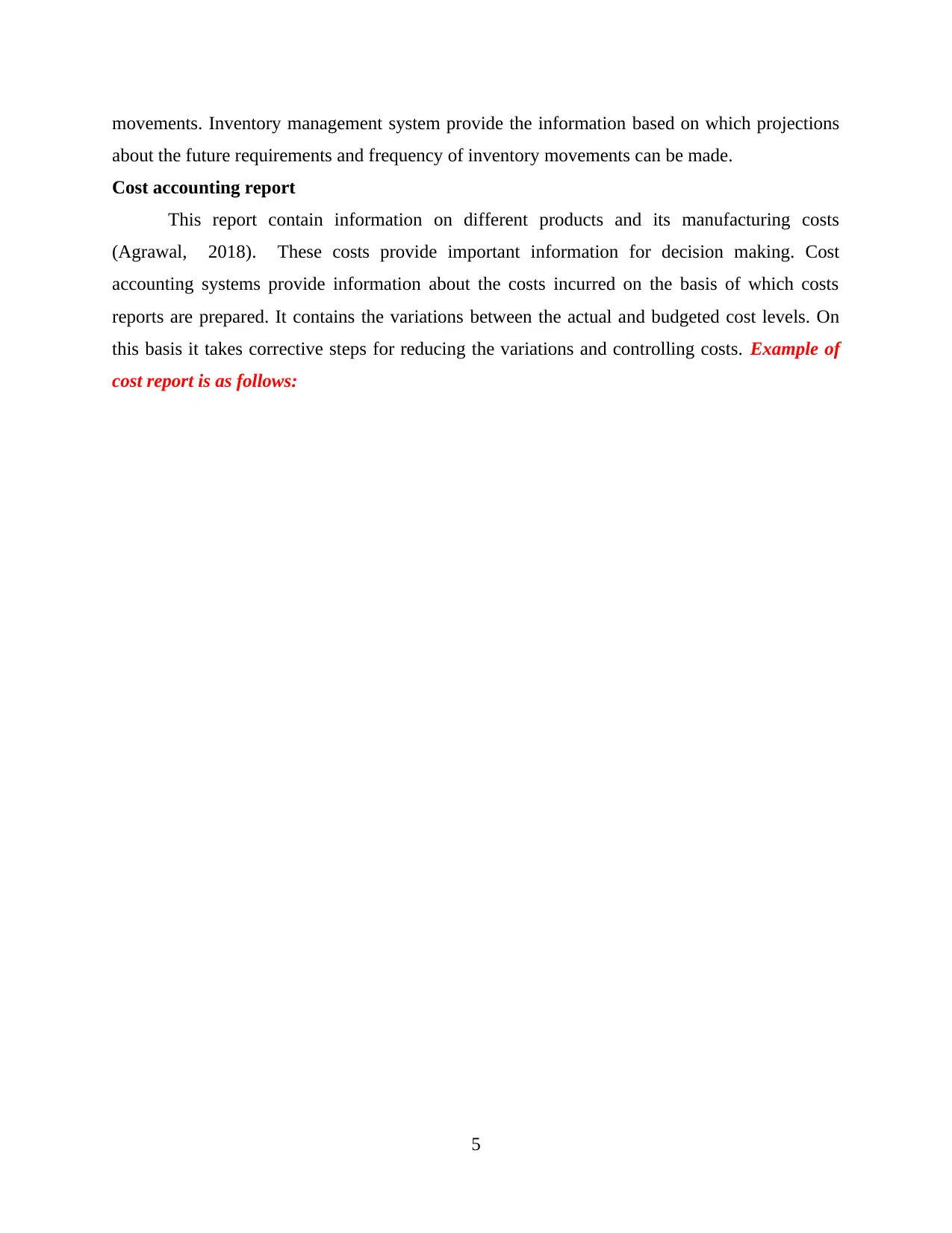
movements. Inventory management system provide the information based on which projections
about the future requirements and frequency of inventory movements can be made.
Cost accounting report
This report contain information on different products and its manufacturing costs
(Agrawal, 2018). These costs provide important information for decision making. Cost
accounting systems provide information about the costs incurred on the basis of which costs
reports are prepared. It contains the variations between the actual and budgeted cost levels. On
this basis it takes corrective steps for reducing the variations and controlling costs. Example of
cost report is as follows:
5
about the future requirements and frequency of inventory movements can be made.
Cost accounting report
This report contain information on different products and its manufacturing costs
(Agrawal, 2018). These costs provide important information for decision making. Cost
accounting systems provide information about the costs incurred on the basis of which costs
reports are prepared. It contains the variations between the actual and budgeted cost levels. On
this basis it takes corrective steps for reducing the variations and controlling costs. Example of
cost report is as follows:
5
Paraphrase This Document
Need a fresh take? Get an instant paraphrase of this document with our AI Paraphraser
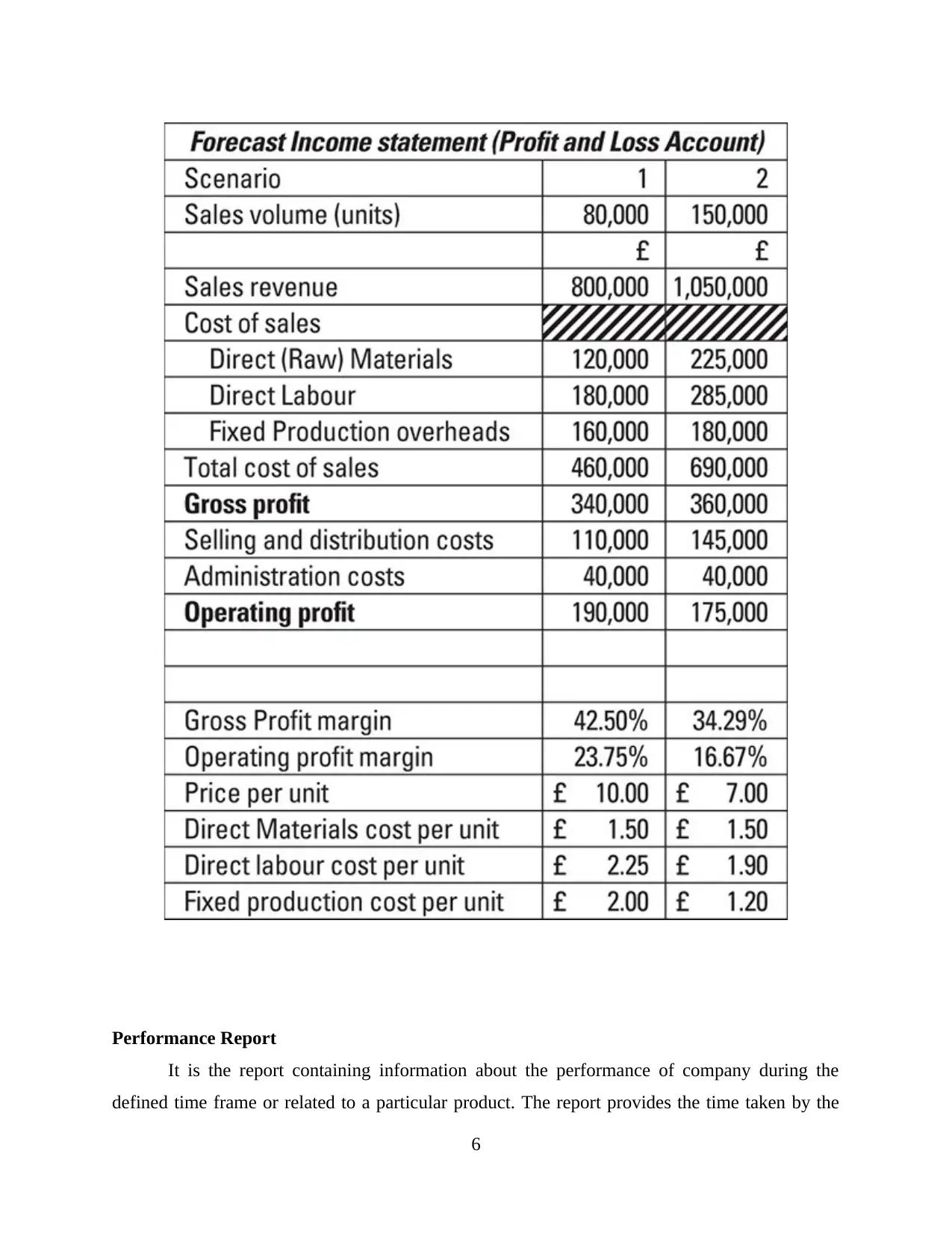
Performance Report
It is the report containing information about the performance of company during the
defined time frame or related to a particular product. The report provides the time taken by the
6
It is the report containing information about the performance of company during the
defined time frame or related to a particular product. The report provides the time taken by the
6
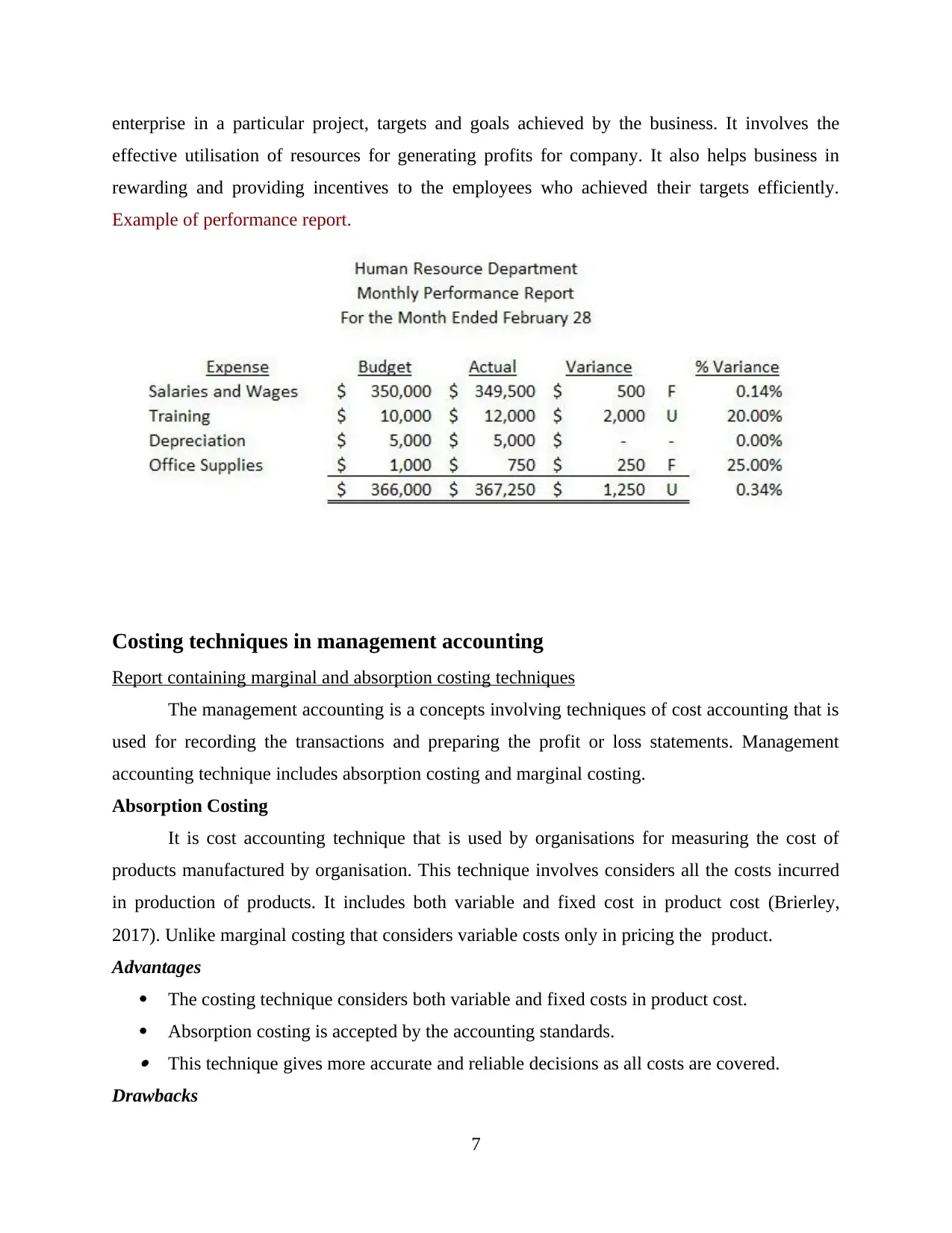
enterprise in a particular project, targets and goals achieved by the business. It involves the
effective utilisation of resources for generating profits for company. It also helps business in
rewarding and providing incentives to the employees who achieved their targets efficiently.
Example of performance report.
Costing techniques in management accounting
Report containing marginal and absorption costing techniques
The management accounting is a concepts involving techniques of cost accounting that is
used for recording the transactions and preparing the profit or loss statements. Management
accounting technique includes absorption costing and marginal costing.
Absorption Costing
It is cost accounting technique that is used by organisations for measuring the cost of
products manufactured by organisation. This technique involves considers all the costs incurred
in production of products. It includes both variable and fixed cost in product cost (Brierley,
2017). Unlike marginal costing that considers variable costs only in pricing the product.
Advantages
The costing technique considers both variable and fixed costs in product cost.
Absorption costing is accepted by the accounting standards. This technique gives more accurate and reliable decisions as all costs are covered.
Drawbacks
7
effective utilisation of resources for generating profits for company. It also helps business in
rewarding and providing incentives to the employees who achieved their targets efficiently.
Example of performance report.
Costing techniques in management accounting
Report containing marginal and absorption costing techniques
The management accounting is a concepts involving techniques of cost accounting that is
used for recording the transactions and preparing the profit or loss statements. Management
accounting technique includes absorption costing and marginal costing.
Absorption Costing
It is cost accounting technique that is used by organisations for measuring the cost of
products manufactured by organisation. This technique involves considers all the costs incurred
in production of products. It includes both variable and fixed cost in product cost (Brierley,
2017). Unlike marginal costing that considers variable costs only in pricing the product.
Advantages
The costing technique considers both variable and fixed costs in product cost.
Absorption costing is accepted by the accounting standards. This technique gives more accurate and reliable decisions as all costs are covered.
Drawbacks
7
⊘ This is a preview!⊘
Do you want full access?
Subscribe today to unlock all pages.

Trusted by 1+ million students worldwide
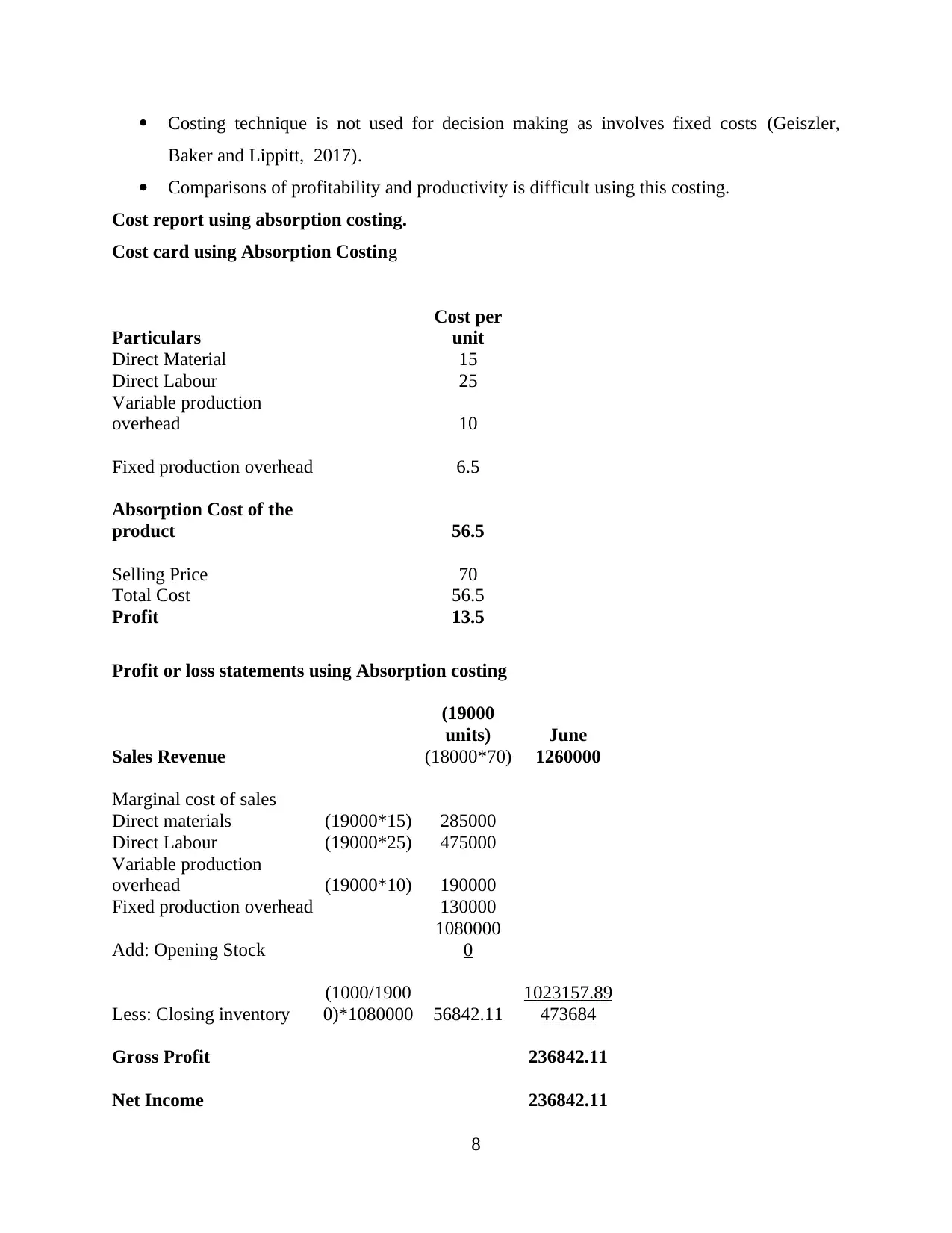
Costing technique is not used for decision making as involves fixed costs (Geiszler,
Baker and Lippitt, 2017).
Comparisons of profitability and productivity is difficult using this costing.
Cost report using absorption costing.
Cost card using Absorption Costing
Particulars
Cost per
unit
Direct Material 15
Direct Labour 25
Variable production
overhead 10
Fixed production overhead 6.5
Absorption Cost of the
product 56.5
Selling Price 70
Total Cost 56.5
Profit 13.5
Profit or loss statements using Absorption costing
(19000
units) June
Sales Revenue (18000*70) 1260000
Marginal cost of sales
Direct materials (19000*15) 285000
Direct Labour (19000*25) 475000
Variable production
overhead (19000*10) 190000
Fixed production overhead 130000
1080000
Add: Opening Stock 0
Less: Closing inventory
(1000/1900
0)*1080000 56842.11
1023157.89
473684
Gross Profit 236842.11
Net Income 236842.11
8
Baker and Lippitt, 2017).
Comparisons of profitability and productivity is difficult using this costing.
Cost report using absorption costing.
Cost card using Absorption Costing
Particulars
Cost per
unit
Direct Material 15
Direct Labour 25
Variable production
overhead 10
Fixed production overhead 6.5
Absorption Cost of the
product 56.5
Selling Price 70
Total Cost 56.5
Profit 13.5
Profit or loss statements using Absorption costing
(19000
units) June
Sales Revenue (18000*70) 1260000
Marginal cost of sales
Direct materials (19000*15) 285000
Direct Labour (19000*25) 475000
Variable production
overhead (19000*10) 190000
Fixed production overhead 130000
1080000
Add: Opening Stock 0
Less: Closing inventory
(1000/1900
0)*1080000 56842.11
1023157.89
473684
Gross Profit 236842.11
Net Income 236842.11
8
Paraphrase This Document
Need a fresh take? Get an instant paraphrase of this document with our AI Paraphraser
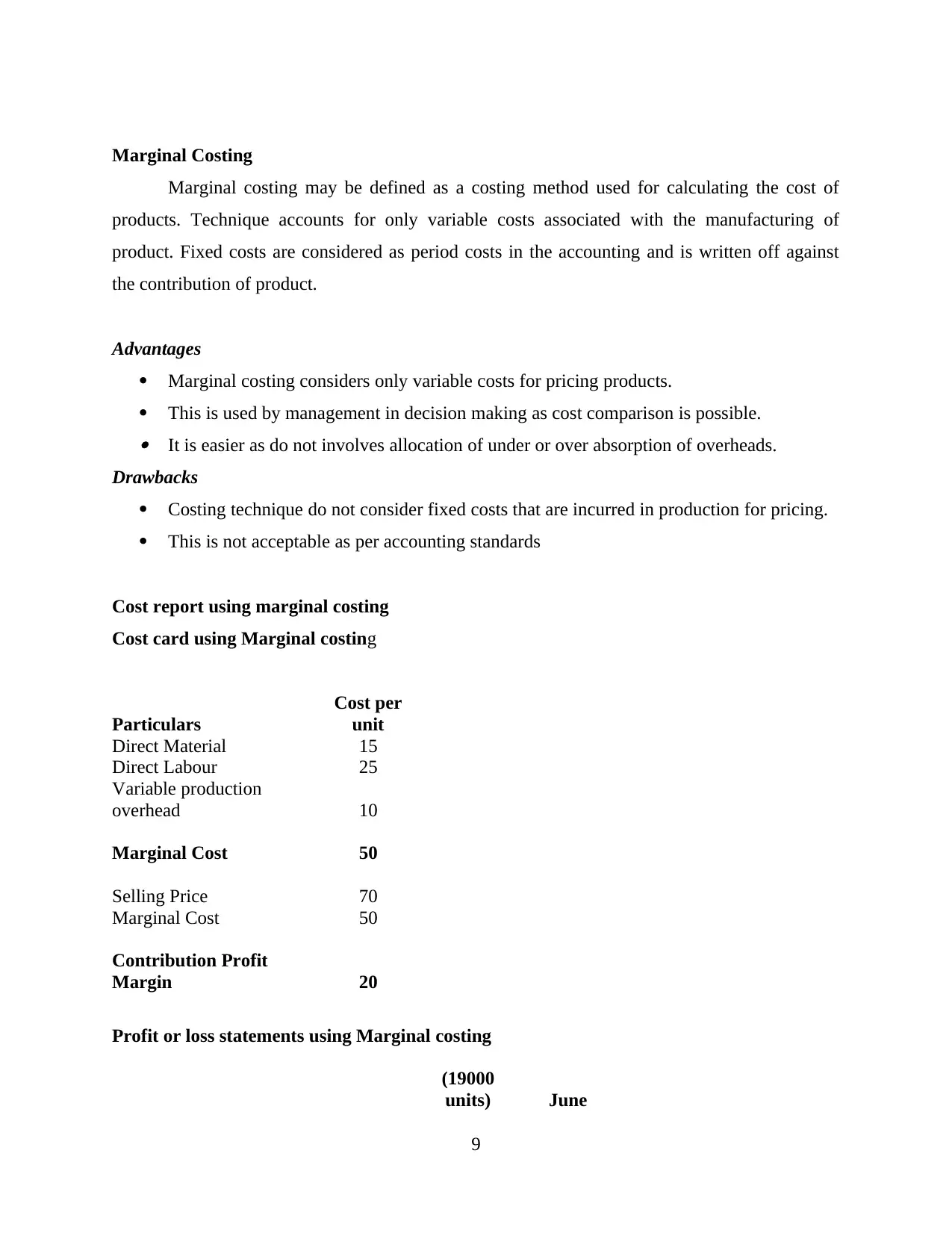
Marginal Costing
Marginal costing may be defined as a costing method used for calculating the cost of
products. Technique accounts for only variable costs associated with the manufacturing of
product. Fixed costs are considered as period costs in the accounting and is written off against
the contribution of product.
Advantages
Marginal costing considers only variable costs for pricing products.
This is used by management in decision making as cost comparison is possible. It is easier as do not involves allocation of under or over absorption of overheads.
Drawbacks
Costing technique do not consider fixed costs that are incurred in production for pricing.
This is not acceptable as per accounting standards
Cost report using marginal costing
Cost card using Marginal costing
Particulars
Cost per
unit
Direct Material 15
Direct Labour 25
Variable production
overhead 10
Marginal Cost 50
Selling Price 70
Marginal Cost 50
Contribution Profit
Margin 20
Profit or loss statements using Marginal costing
(19000
units) June
9
Marginal costing may be defined as a costing method used for calculating the cost of
products. Technique accounts for only variable costs associated with the manufacturing of
product. Fixed costs are considered as period costs in the accounting and is written off against
the contribution of product.
Advantages
Marginal costing considers only variable costs for pricing products.
This is used by management in decision making as cost comparison is possible. It is easier as do not involves allocation of under or over absorption of overheads.
Drawbacks
Costing technique do not consider fixed costs that are incurred in production for pricing.
This is not acceptable as per accounting standards
Cost report using marginal costing
Cost card using Marginal costing
Particulars
Cost per
unit
Direct Material 15
Direct Labour 25
Variable production
overhead 10
Marginal Cost 50
Selling Price 70
Marginal Cost 50
Contribution Profit
Margin 20
Profit or loss statements using Marginal costing
(19000
units) June
9
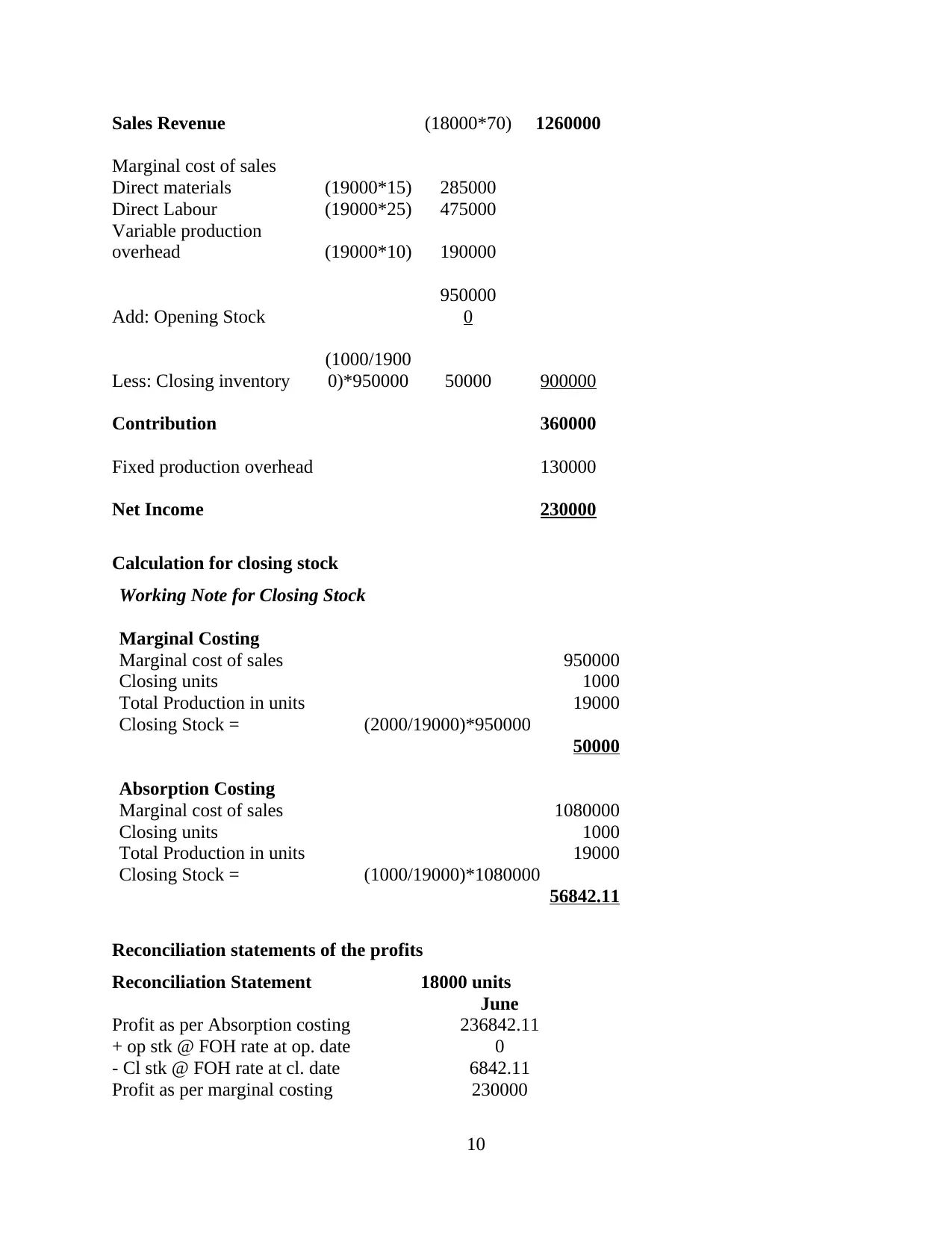
Sales Revenue (18000*70) 1260000
Marginal cost of sales
Direct materials (19000*15) 285000
Direct Labour (19000*25) 475000
Variable production
overhead (19000*10) 190000
950000
Add: Opening Stock 0
Less: Closing inventory
(1000/1900
0)*950000 50000 900000
Contribution 360000
Fixed production overhead 130000
Net Income 230000
Calculation for closing stock
Working Note for Closing Stock
Marginal Costing
Marginal cost of sales 950000
Closing units 1000
Total Production in units 19000
Closing Stock = (2000/19000)*950000
50000
Absorption Costing
Marginal cost of sales 1080000
Closing units 1000
Total Production in units 19000
Closing Stock = (1000/19000)*1080000
56842.11
Reconciliation statements of the profits
Reconciliation Statement 18000 units
June
Profit as per Absorption costing 236842.11
+ op stk @ FOH rate at op. date 0
- Cl stk @ FOH rate at cl. date 6842.11
Profit as per marginal costing 230000
10
Marginal cost of sales
Direct materials (19000*15) 285000
Direct Labour (19000*25) 475000
Variable production
overhead (19000*10) 190000
950000
Add: Opening Stock 0
Less: Closing inventory
(1000/1900
0)*950000 50000 900000
Contribution 360000
Fixed production overhead 130000
Net Income 230000
Calculation for closing stock
Working Note for Closing Stock
Marginal Costing
Marginal cost of sales 950000
Closing units 1000
Total Production in units 19000
Closing Stock = (2000/19000)*950000
50000
Absorption Costing
Marginal cost of sales 1080000
Closing units 1000
Total Production in units 19000
Closing Stock = (1000/19000)*1080000
56842.11
Reconciliation statements of the profits
Reconciliation Statement 18000 units
June
Profit as per Absorption costing 236842.11
+ op stk @ FOH rate at op. date 0
- Cl stk @ FOH rate at cl. date 6842.11
Profit as per marginal costing 230000
10
⊘ This is a preview!⊘
Do you want full access?
Subscribe today to unlock all pages.

Trusted by 1+ million students worldwide
1 out of 22
Related Documents
Your All-in-One AI-Powered Toolkit for Academic Success.
+13062052269
info@desklib.com
Available 24*7 on WhatsApp / Email
![[object Object]](/_next/static/media/star-bottom.7253800d.svg)
Unlock your academic potential
Copyright © 2020–2025 A2Z Services. All Rights Reserved. Developed and managed by ZUCOL.





